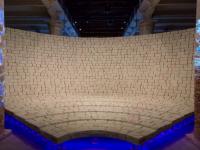Xiao Feng Museum
Hangzhou, China
The museum is entirely dedicated to the work of the painter Xiao Feng and his wife Song Ren. The building was supposed to be built on a site on the edge of the Longjing forest just few minutes drive from the famous Hangzhou West Lake. Instead of the usual frontal and monumental museum typology, BaO designed a long bridge building carefully winding between the existing tress. The site being of utmost beauty, the architecture of the museum tries to humbly dissolve in it, it is ambiguous, camouflaged in the trees canopies and is never quite understandable as a whole. One has to cross the forest, engage on a pond, or take a hidden elevator in the forest to discover step by step the stone-like museum that has been entirely enveloped by a veil made out of of local traditional dark grey tiles.
Our ambition was to create a museum where sensory experience prevailed. In this sense the design contradicts the typical museums typology that tend to focus on creating an architectural tour de force and where visual and sculptural impact are paramount. The Xiao Feng Museum is thus playfully hiding in the forest, the visitors cannot grasp it in its entirety, it's a museum where one slowly discover the spaces and the art works; a museum where one takes pleasure in not knowing what will happen. The winding plan makes movement compulsory, one has to move through the museum to uncover the collection. The black tiles curtain facade similarly tries to blurs the understanding of how the museum is organized. After entering the building from below, the visitor realizes that a dialectic between two types of gallery spaces is at play. The museum alternates between introverted, slick, immaculate white neutral gallery spaces, and extroverted, rough, and porous buffer zones. The black tiles veil enveloping the whole building reappears in those chosen moments to act as a mineral screen filtering light and views on the surrounding forest that thus become integrated parts of the curatorial experience. The typical puritanism of the "white neutral art space" that too often characterizes museums is here counterbalanced by gallery spaces in which the natural environment, the rough materiality of the building and unaltered sunlight are welcomed.












